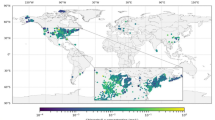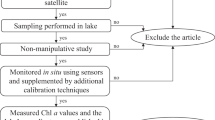Abstract
In Europe there is a renewed focus on relationships between chemical determinands and ecological impact as a result of the Water Framework Directive (WFD). In this paper we use regression analysis to examine the relationship of growing season mean chlorophyll a concentration with total phosphorus and total nitrogen using summary data from over 1,000 European lakes. For analysis, lakes were grouped into types with three categories of mean depth, alkalinity and humic content. The lakes were also divided into broad geographic regions covering Atlantic, Northern, Central/Baltic and for some types the Mediterranean areas of Europe. Chlorophyll a was found to be significantly related to both total phosphorus and total nitrogen, although total phosphorus was almost always found to be the best predictor of chlorophyll. Different nutrient chlorophyll relationships were found for lakes according to mean depth and alkalinity, although no significant effect of geographic region or humic content was found for the majority of lake types. We identified three groups of lakes with significantly different responses. Deep lakes had the lowest yield of chlorophyll per unit of nutrient, low and moderate alkalinity shallow lakes the highest and high alkalinity lakes were intermediate. We recommend that the regression models provided for these three lake groups should be used for lake management in Europe and discuss the limitations of such models.






Similar content being viewed by others
References
Canfield DE (1983) Prediction of chlorophyll a concentrations in Florida lakes: the importance of phosphorus and nitrogen. Wat Res Bull 19:255–262
Clasen J, Bernhardt H. (1980) OECD Eutrophication programme. Shallow lakes and reservoirs project. Final report. Water Research Centre. Marlow UK.
Cleveland WS (1979) Robust locally weighted regression and smoothing scatterplots. J Am Stat Assoc 74:829–836
Dillon PJ, Rigler FH (1974) The phosphorus–chlorophyll relationship in lakes. Limnol Oceanogr 28:792–795
Downing J, McCauley E (1992) The nitrogen–phosphorus relationship in lakes. Limnol Oceanogr 37:936–945
Edmundson JA, Carlson SR (1998) Lake typology influences on the phosphorus–chlorophyll relationship in subarctic, Alaskan lakes. Lake Reserv Manage 14:440–450
Field A (2005) Discovering statistics using SPSS. SAGE Publications, London
Forsberg C, Ryding SO (1980) Eutrophication parameters and trophic state indices in 30 Swedish waste-receiving lakes. Arch Hydrobiol 89:189–207
Håkanson L, Blenckner T, Bryhn C et al (2005) The influence of calcium on the chlorophyll–phosphorus relationship and lake secchi depths. Hydrobiol 537:111–123
Havens KE (2003) Phosphorus–algal bloom relationships in large lakes of south Florida. Lake Reserve Manage 19:222–228
Havens KE, Nürnberg GK (2004) The phosphorus–chlorophyll relationship in lakes:potential influences of colour and mixing regime. Lake Reserv Manage 20:188–196
Jones C, Bachmann RW (1976) Prediction of phosphorus and chlorophyll levels in lakes. J Water Pollut Control Fed 48:2176–2182
Jones RI (1998) Phytoplankton, primary production and nutrient cycling. In: Hessen DO, Tranvik L (eds) Aquatic humic substances. ecology and biochemistry. Ecological studies 133. Springer, Berlin, pp 145–175
Moe SJ, Dudley B, Ptacnik R (2008) Databases: experiences from compilation and analyses of monitoring data from 5,000 lakes in 20 European countries. Aquat Ecol. doi:10.1007/s10452-008-9190-y
Myers R (1990) Classical and modern regression with applications. Duxbury, Boston, MA
Nürnberg GK (1996) Trophic state of clear and colored, soft- and hard-water lakes with special consideration of nutrients, anoxia, phytoplankton and fish. Lake Reserv Manage 12:432–447
Nürnberg GK, Shaw M (1999) Productivity of clear and humic lake: nutrient, phytoplankton, bacteria. Hydrobiol 382:97–112
OECD (1982) Eutrophication of waters monitoring assessment and control. Final report. OECD cooperative programme on monitoring of inland waters. OECD, Paris
Phillips GL (2003) Eutrophication of shallow temperate lakes. In: O’Sullivan P, Reynolds C (eds) The lakes handbook volume 2, lake restoration and rehabilitation. Blackwell, Oxford, pp 261–278
Prairie YT (1996) Evaluating the predictive power of regression models. Can J Fish Aquat Sci 53:490–492
Prairie YT, Duarte CM, Kalff J (1989) Unifying nutrient-chlorophyll relationships in lakes. Can J Fish Aquat Sci 46:1176–1182
Rast W, Lee GF (1978) Summary analysis of the North American (U.S.) OECD Eutrophication project: Nutrient load in-lake response relationships and trophic state indices. U.S. EPA-600/3-78-008
Reynolds C (1980) Eutrophication and the management of planktonic algae: what Vollenweider couldn’t tell us. In: Sutcliffe DW, Jones G (eds) Eutrophication: research and application to water supply. Freshwater Biological Association, Ambleside, pp 4–29
Ryding SO, Rast W (1989) The control of eutrophication of lakes and reservoirs. UNESCO, Paris
Sakamoto M (1966) Primary production by phytoplankton community in some Japanese lakes and its dependence on lake depth. Arch Hydrobiol 62:1–28
Scheffer M (1990) Multiplicity of stable states in freshwater systems. Hydrobiol 200/201:475–486
Seip KL, Jeppesen E, Jensen JP, Faafeng B (2000) Is trophic state or regional location the strongest determinant for Chl-a/TP relationships in lakes? Aquat Sci 62:195–204
Smith VH (1982) The nitrogen and phosphorus dependence of algal biomass in lakes: an empirical and theoretical analysis. Limnol Ocearnogr 23:1248–1255
Stauffer RE (1991) Environmental factors influencing chlorophyll v. nutrient relationships in lakes. Freshwat Biol 25:279–295
Van de Bund W, Cardoso AC, Heiskanen AS, Noges P (2004) Overview of common intercalibration types. http://wfd-reporting.jrc.cec.eu.int/Docs/typesmanual
Vollenweider RA (1976) Advances in defining critical loading levels for phosphorus in lake eutrophication. Schweitz Z Hydrol 37:53–84
Vollenweider RA, Kerekes J (1980) The loading concept as a basis for controlling eutrophication philosophy and preliminary results of the OECD programme on eutrophication. Prog Wat Rech 12:5–38
White E (1983) Lake eutrophication in New Zealand–a comparison with other countries of the Organisation for Economic Co-operation and Development. N Z J Marine Freshwater Res 17:437–444
Author information
Authors and Affiliations
Corresponding author
Appendices
Appendices
Appendix 1. Relationship between summer mean total phosphorus (μg l−1) and chlorophyll a (μg l−1) in lakes grouped by alkalinity and mean depth. Solid lines show modelled regressions, upper and lower 90% confidence intervals. Dotted lines show modelled regressions ±95th percentile of regression residuals. 
Appendix 2. Equations to calculate expected chlorophyll a from total phosphorus. The upper and lower boundary values are very similar to the 90% confidence limit of the regression and are determined by adding the 95th and 5th percentiles of the regression residuals. For any particular TP value approximately 90% of lakes will have a chlorophyll concentration below the upper boundary and above the lower boundary.
Model 5 Low and moderate alkalinity, shallow and very shallow lakes | |
Upper boundary | Log10[Chl] = −0.528 + 1.108 Log10[TP] + 0.278 |
Regression | Log10[Chl] = −0.528 + 1.108 Log10[TP] |
Lower boundary | Log10[Chl] = −0.528 + 1.108 Log10[TP] − 0.346 |
Model 6 High alkalinity shallow and very shallow lakes | |
Upper boundary | Log10[Chl] = −0.306 + 0.868 Log10[TP] + 0.352 |
Regression | Log10[Chl] = −0.306 + 0.868 Log10[TP] |
Lower boundary | Log10[Chl] = −0.306 + 0.868 Log10[TP] + −0.500 |
Model 7 All deep lakes | |
Upper boundary | Log10[Chl] = −0.286 + 0.776 Log10[TP] + 0.306 |
Regression | Log10[Chl] = −0.286 + 0.776 Log10[TP] |
Lower boundary | Log10[Chl] = −0.286 + 0.776 Log10[TP] + 0.305 |
Rights and permissions
About this article
Cite this article
Phillips, G., Pietiläinen, OP., Carvalho, L. et al. Chlorophyll–nutrient relationships of different lake types using a large European dataset. Aquat Ecol 42, 213–226 (2008). https://doi.org/10.1007/s10452-008-9180-0
Published:
Issue Date:
DOI: https://doi.org/10.1007/s10452-008-9180-0




